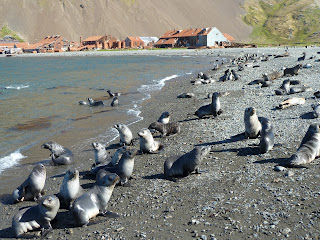Four years later, Captain Scott and his party followed Shackleton's route and died after reaching the South Pole. He was 11 miles from a food depot.
 |
| Booth Island, Antarctica |
So, I have always admired Shackleton's decision to turn back, when he knew he could have been first to reach the Pole. This year, I've achieved a dream and walked in the footsteps of Shackleton - on South Georgia. In 1914, he set out to cross the Antarctic continent. He never reached it.
On South Georgia in the South Atlantic, he was loading his ship with its final provisions for the journey, when whalers warned him the ice that year was the worst they'd ever encountered. And, sure enough, his ship, the Endurance, was trapped in pack ice for months and eventually crushed and sunk.
The 27-man expedition drifted on pack ice for months, and then rowed the small boats they'd retrieved from Endurance across the sea to Elephant Island. From there, Shackleton and 5 others sailed a small boat 750 miles to South Georgia - to try to raise a rescue from the whalers he'd met there when he'd set out for Antarctica almost 2 years previously. It was one of the greatest sea voyages ever.
 |
| Seals oblivious to the ruins of Stromness whaling station |
 |
| Seals and penguins have no fear of Man... |
But the party still had to get to the whaling station on the other side of the island - some 25 miles across uncharted mountains and glaciers.
 |
| South Georgia with Crean's Lake. |
The photo above shows a lake which was frozen when Shackleton's party passed. One of the men, Tom Crean, fell through the ice, but was rescued. Shortly afterwards, the men would have had a similar view to the one below.
 |
| Stromness |
The whole story is worth reading, both Shackleton's diaries, and biographies.
I and others were lucky enough recently to have had the opportunity to walk the last 4 miles of his route. In pleasant conditions, it was wonderful, but it would not have been pleasant with ice underfoot to half-starved, sleep-deprived men. Their fortitude is beyond my comprehension.
But just in case you wondered where the Nordic Walking connection is, during the walk we met a local lady who never went anywhere without her poles. She strode past us, with the extra traction from her poles. I wish I could have packed mine!
 |
| South Georgia resident, with poles! |
More on Shackleton and South Georgia, later.
Peter
07703-404-931

No comments:
Post a Comment